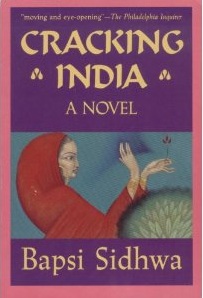Cracking India
by Bapsi Sidhwa
Review By Dan Geddes
Cracking India tells the story of the partition of India through the eyes of young Lenny, a Parsee girl growing up in Lahore. Lenny narrates the events of her family and native Lahore over more than a ten year period, from before World War II to just after Indian independence and the partition. The power of Cracking India stems from Sidwha’s creation of an idyllic picture of Lenny’s childhood, and the relative inter-racial harmony of pre-Independence Lahore. We then watch with horror as the people around Lenny divide along racial/religious lines and eventually slaughter one another. Historical fiction such as Cracking India shows us history in miniature, making it far more vivid than mere statistics about the numbers slaughtered during the tragic events of 1947-48.
Although the story is set against the backdrop of India independence, it is equally the story of Lenny’s maturation from a four-year-old limping girl to a young woman of growing sexual awareness. As a young girl she sits in the Queen’s garden with her Ayah, her nanny, who is nubile and the object of desire for a large circle of young men of many races and creeds. Young Lenny perceives their eyes burning for Ayah, their furtive attempts to touch her with their hands, mouths, even their toes. Her education about sexuality thus begins early, though Sidhwa delights in showing us Lenny’s later sexual discoveries as well, such as her growing aware of her Cousin’s body.
Much of the novel seems derived from Sidhwa’s autobiographical experience, and this explains much of the narrative’s power. Lenny’s perceptiveness makes her an effective narrator, though it takes some time to get used to a four-year-old making the insights that Lenny does. Lenny is already conscious of people treating her differently because of her limp. Lenny senses people’s motivations, and spots their most telling gestures. She describes the mixed blessings of her own honesty, showing self-awareness as well. But her honesty, her “cursed tongue” as she calls it, also betrays her beloved Ayah, a Hindu, whom Lenny mistakenly betrays to Ice-Candy Man.
Much of the story’s charm comes from Lenny’s acute descriptions of her childhood. She experiences the joys of visiting her family cook’s native town, savoring stolen bits of chicken giblets in the kitchen during her parent’s dinner parties, and hiding under the table and making profound insights about the guests’ personality based on the movements of their legs and feet. But her greatest joy is her Ayah, a sublime being whose attractions ensure that Lenny herself always has plenty of company.
This motley collection of Ayah’s admirers, suggesting the diversity of all India in miniature, consists of around 12 men including at least one Sikh, a Muslim, a Hindu, and Parsee all with different occupations. Their peaceful co-existence in their competition for Ayah’s affections suggests the larger inter-racial amity in Lahore. While some of this inter-racial co-operation is based on a common abhorrence of British rule, it is also based on centuries of living together, as the characters themselves state outright.
So the ancient city of Lahore is torn asunder by Western-style nationalism and nation-state building—one of many lasting wounds from British rule. As Lenny observes: “It is sudden. One day everybody is themselves—and the next day they are Hindu, Muslim, Sikh, Christian. People shrink, dwindling into symbols. Ayah is no longer just my all-encompassing Ayah—she is also a token. A Hindu.…” (101).
As much as the story of Cracking India owes to its historical setting, its scope is local: Lahore. Historical events, and personages such as Nehru, Gandhi, Jinnah are far away (except for a comical meeting between Gandhi and Lenny and her mother), and their effect on Lahore is delayed. For the first third of the novel, the idyll of Lenny’s childhood is nearly untouched by the gathering storm. The middle third depicts the outbreak of violence and the destruction of pre-Pakistani Lahore, including Ayah’s circle. The novel’s climax is Ice-Candy’s betrayal of Ayah, by extracting her hiding-place from the trusting Lenny. From there, events proceed quickly, for we are as captivated by Ayah as her circle of admirers.
The last third of the novel showcases the efforts of Lahore’s women to repair the damage done to the community by the men. Lenny’s mother leads other women in smuggling gasoline in order to raise money to send defamed women back to their families. Lenny’s Godmother is revealed to be a matriarch of considerable powers and influence. She is able to locate the violated Ayah, and rescue her from Ice-Candy Man’s clutches, and send her back to her family in India.
Lenny-as-narrator undergirds the novel’s feminine perspective. While some male characters, such Masseur, Lenny’s father, and Cousin, are treated sympathetically, many male characters are seen as encircling predators of sex or violence. Lenny’s persepective is formed while she sits next to Ayah in the middle of her circle of admirers. Ice-Candy Man’s betrayal is especially shocking, because as a popsicle salesman he has a rapport with children that leads to Lenny’s misguided trust in him at the crucial moment of Ayah’s fate.
Perhaps mindful of her Western audience, Sidhwa throws in some allusions to Western literature. The Ice-Candy Man is allusion to Eugene O’Neill’s The Iceman Cometh, which in turn alluded to Gospels, wherein Jesus foretold that the “bridegroom [of the church, i.e., God] cometh.” O’Neill’s play depicted a group of 13 drunks (deliberately 13 to suggest Christ and his 12 apostles) revolving around the salesman Hickey, the Iceman of life-killing cold truths, who shatters the personal illusions, the “pipe-dreams” of the other 12 in the circle. Similarly, Ayah, has a circle of twelve followers. The Ice-Candy Man, the Judas figure, betrays his beloved Ayah, and shatters the amicable illusion of Ayah’s circle, revealing the cauldron of lust that had always inspired it.
Sidhwa succeeds by focusing on the personal level of events. She offers no novel explanation for the violence that engulfed the partition. We are shown only a handful of fully-drawn characters. Lenny’s child-like eyes are ideal for showing us the horrors of civil war. And yet it is surprising how dispassionately Lenny reacts to the madness around her, even years later as she is narrating the events. It is almost as if her desire for objectivity as a narrator was stronger than her emotions to the horrors of war. The beauty of the language shows the narrator telling us the Lenny’s story is stronger than the child who witnessed the atrocities. But without such narrative strength we might not have this particular story at all.
March 2000






Be First to Comment